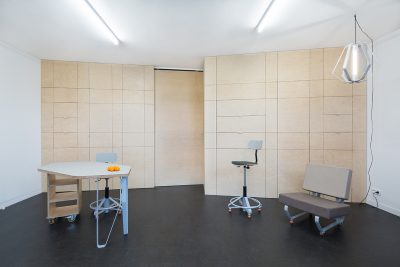Artistic creation is characterized by an infinity of practices. The mutation of tools and exhibition media, their hybridization, the versatility of artists and the creation of both solitary and collective, add to the unpredictability of configurations and needs in terms of space usage, beyond profiles and disciplines.
In this restructuring of artists’ studios and apartments, the living room and the workplace are one and the same.
Our design concept have been developed around the modularity of the artist himself. Because creators must move, arrange, stage their space of creation and life. The question is how the artist will be able to play with furniture to set it in the best conditions to create. This priority led us to push the modularity of the furniture much further than if we had considered the redevelopment of these three workshops only from the angle of an architectural problem.
We thought space in terms of cell, element that has similarities with the cabin, as a homogeneous refuge of intimacy and refocusing. The cell has the advantage of being split, at will, to accommodate a visit, a collaborator, or an audience (exhibitions in open studio for example). The multiplicity of possibilities of opening the double intimate space of the workshop and the lodging offers the possibility of a choice in the allocated space. This modularity encourages maneuvering, a simple action conducive to the appropriation of space and to satisfaction and well-being.
This advanced modularity revolves around a structuring element: the bed, envisaged as a vehicle within the space. Comforting element for rest or reception depending on its configuration (bed-alcove or sofa-sofa), it is also dedicated to storage, with its library and integrated shelves, partitioning or masking, it can be used as a screen. At night, the bed becomes an illuminating object, with direct or indirect light. Cut in half, it helps to preserve the sleep of one and the work of the other.
















